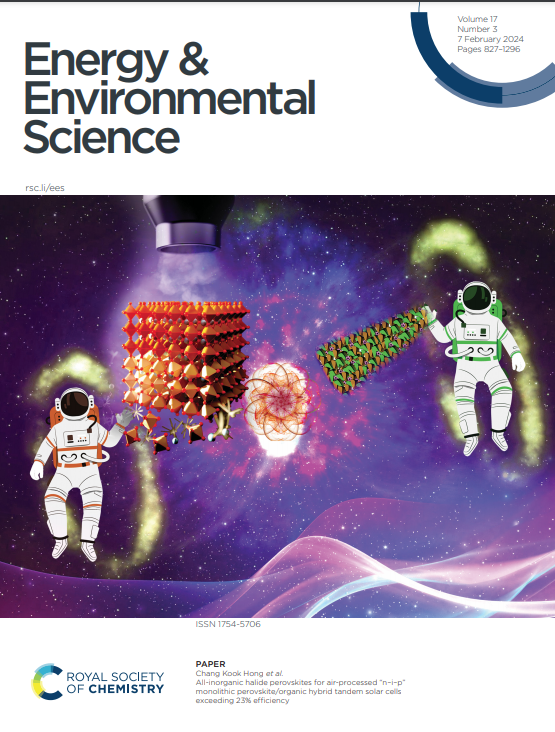Asymmetric Functional Gel Polymer Electrolyte Enables Superior Interfacial Compatibility for Wide Temperature Lithium Metal Batteries
IF 30.8
1区 材料科学
Q1 CHEMISTRY, MULTIDISCIPLINARY
引用次数: 0
Abstract
Lithium metal batteries (LMBs) represent a promising candidate for next-generation energy storage systems, yet their practical application is constrained by limited cycle life owing to slow interface Li+ ion transport and severe interfacial side reactions, particularly in extreme temperature conditions. Herein, a novel asymmetric gel polymer electrolyte (GPE) is constructed through sequential electrospinning and Li6.4La3Zr1.4Ta0.6O12 (LLZTO) filler integration to achieve high compatibility with Li anode and high-voltage cathode over wide temperature range. The polyethylene oxide (PEO)/poly(vinylidene fluoride-co-hexafluoropropylene) (PVDF-HFP) matrix adjacent to the Li anode homogenizes Li⁺ ion flux and facilitates the formation of stable solid electrolyte interphase (SEI) through dynamic interfacial remodeling. At the cathode side, the polyacrylonitrile (PAN)/PVDF-HFP matrix exhibits outstanding high-voltage tolerance, effectively suppressing transition metal dissolution and electrolyte decomposition. The incorporated LLZTO enhances LiPF6 dissociation via selective adsorption. The highly porous asymmetric polymer framework architecture facilitates the elimination of macroscopic interfaces among dissimilar materials, achieving fast Li⁺ ion transport. Consequently, the Li||Ni0.8Co0.1Mn0.1O2 cells exhibit outstanding wide temperature cycling of -30 to 70 °C. This asymmetric structure design of GPE offers valuable insights into interfacial engineering exploration for all-climate LMBs.不对称功能凝胶聚合物电解质为宽温度锂金属电池提供优越的界面兼容性
锂金属电池(lmb)代表了下一代储能系统的有希望的候选者,但由于界面Li+离子传输缓慢和严重的界面副反应,特别是在极端温度条件下,它们的实际应用受到循环寿命有限的限制。本文通过序次静电纺丝和Li6.4La3Zr1.4Ta0.6O12 (LLZTO)填料的集成,构建了一种新型的不对称凝胶聚合物电解质(GPE),实现了与Li阳极和高压阴极在宽温度范围内的高相容性。毗邻Li阳极的聚环氧乙烷(PEO)/聚偏氟乙烯-共六氟丙烯(PVDF-HFP)基体使Li⁺的离子通量均匀化,并通过动态界面重塑促进稳定固体电解质界面相(SEI)的形成。在阴极侧,聚丙烯腈(PAN)/PVDF-HFP基质表现出出色的高压耐受性,有效抑制了过渡金属的溶解和电解质分解。掺入的LLZTO通过选择性吸附增强LiPF6的解离。高度多孔的不对称聚合物框架结构有助于消除不同材料之间的宏观界面,实现Li +离子的快速传输。因此,Li||Ni0.8Co0.1Mn0.1O2电池表现出-30至70°C的宽温度循环。这种GPE的非对称结构设计为全气候lmb的界面工程探索提供了有价值的见解。
本文章由计算机程序翻译,如有差异,请以英文原文为准。
求助全文
约1分钟内获得全文
求助全文
来源期刊

Energy & Environmental Science
化学-工程:化工
CiteScore
50.50
自引率
2.20%
发文量
349
审稿时长
2.2 months
期刊介绍:
Energy & Environmental Science, a peer-reviewed scientific journal, publishes original research and review articles covering interdisciplinary topics in the (bio)chemical and (bio)physical sciences, as well as chemical engineering disciplines. Published monthly by the Royal Society of Chemistry (RSC), a not-for-profit publisher, Energy & Environmental Science is recognized as a leading journal. It boasts an impressive impact factor of 8.500 as of 2009, ranking 8th among 140 journals in the category "Chemistry, Multidisciplinary," second among 71 journals in "Energy & Fuels," second among 128 journals in "Engineering, Chemical," and first among 181 scientific journals in "Environmental Sciences."
Energy & Environmental Science publishes various types of articles, including Research Papers (original scientific work), Review Articles, Perspectives, and Minireviews (feature review-type articles of broad interest), Communications (original scientific work of an urgent nature), Opinions (personal, often speculative viewpoints or hypotheses on current topics), and Analysis Articles (in-depth examination of energy-related issues).
 求助内容:
求助内容: 应助结果提醒方式:
应助结果提醒方式:


